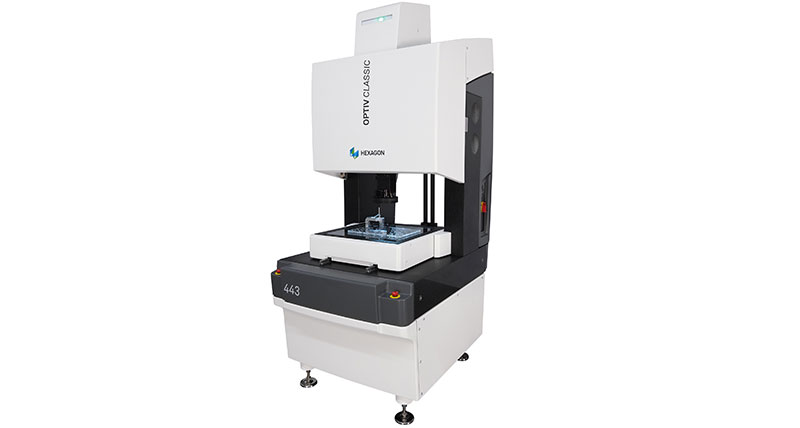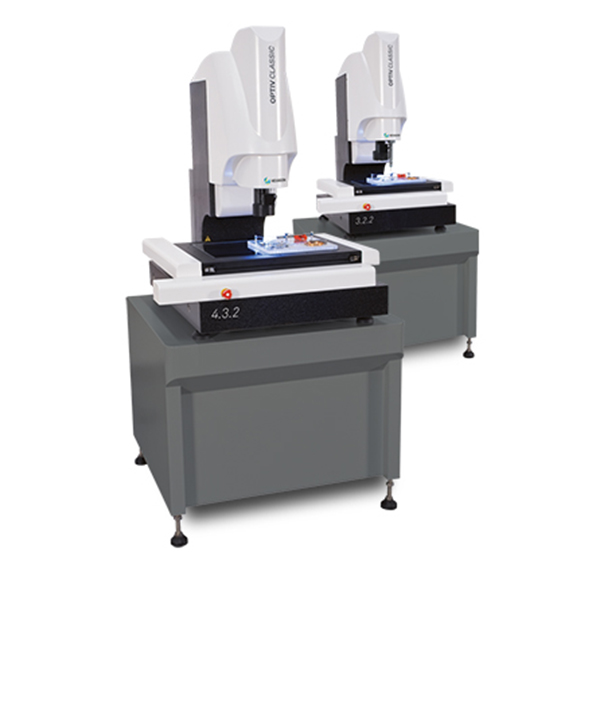Six reasons to reevaluate optical comparators
Is an optical comparator a versatile enough vision measurement tool for long-term metrology needs?
Contact us

As beneficial as a simple solution such as an optical comparator can be for users, there are a few things to consider. Wolfram Fröhlich, Business Unit Director PL sCMM (Vision Unit) from Hexagon Manufacturing Intelligence explores six reasons why optical comparators may not be the best choice and how an all-in-one alternative solution may be more beneficial.
Since its release, many modifications have been made to this technology, including adding basic edge detection and microprocessors that enable users to measure simple geometry two dimensionally automatically in-order to increase their capability. Optical comparators are valued because of the simplicity of the system and its operation.
Simplicity can be compelling, however, with simplicity comes major drawbacks in functionality that could be costing more in the long run and here’s why:
This CMM performs at a much higher resolution than a standalone optical comparator. The zoom capability allows magnification to be changed at any position for a higher resolution, collecting not only a profile but top-lit data with speed and accuracy. With the Optiv Classic 443, the two available surface illuminations provide a crisp edge for automatic detection, allowing the surface information to be easily seen.
Combining automated inspection capabilities with PC-DMIS CAD for Vision allows programming of the machine directly from the CAD model. Operators can continue to run a program automatically simply by creating a part program once. And if they’re already using PC-DMIS, then they are already familiar with how to program this Vision system.
In larger production environments when multiple Optiv Classic machines are required, transferring programs from one machine to another with no loss of accuracy is easy. PC-DMIS uses a full model ensuring three-dimensional inspection to a full GD&T. Plus, with PC-DMIS reporting, records of previous measurement can be viewed easily, ensuring customers can prove part validity and traceability.
In a shop-floor environment, the Optiv Classic 443 excels due to its design. The solution provides users with recessed optic lighting to avoid contamination, giving customers the confidence they need to obtain accurate results. The calibrated light and camera setup also ensures that the CMM is unaffected by changes in ambient light.
The benefits to obtaining an all-in-one solution as compared to a restricted system are substantial. Companies are constantly looking for more ways to future-proof their investments by selecting solutions which can adapt easily to changing requirements. With so many benefits on offer, flexible solutions such as the Optiv Classic 443 look to be the direction more companies are taking in the future.
What is an optical comparator?
The optical comparator is a device used for optical measurement to provide visual inspection of a component. Conventionally, the optical comparator was used in conjunction with an overlay of polyester film, known as Mylar. In engineering, the design or CAD department would use an inkjet printer to print a large-scaled image of the product and its tolerances onto the Mylar. The operator would then place the Mylar-enlarged image on the machine to compare with the product.Since its release, many modifications have been made to this technology, including adding basic edge detection and microprocessors that enable users to measure simple geometry two dimensionally automatically in-order to increase their capability. Optical comparators are valued because of the simplicity of the system and its operation.
Simplicity can be compelling, however, with simplicity comes major drawbacks in functionality that could be costing more in the long run and here’s why:
1. Lack of quantitative data
As organisations leverage manufacturing information, quantitative data is becoming increasingly more important to everyday operation. Today, quantitative manufacturing data for businesses in need of manufactured parts is essential for business operations. Optical comparators are being put to the test as companies will no longer accept attribute gauge inspection as a validated data point. In fact, companies using optical comparators in the medical field are facing an even bigger challenge, as the FDA is starting to standardise quantifiable data of an inspected part, rather than accepting visual inspection data to ensure quality of product.2. Low resolution
One advantage of optical comparators is the large field of view, allowing engineers to see the entire component at one time. However, the wide field of view poses a problem of lower resolution – resulting in lower accuracy. The optical comparator is great for applications that have a backlit component profile, as it is very clearly defined. On the contrary, for surface information, it is much more challenging. Take for example a square block with a blind hole. If a hole is not able to be lit by backlight, or a surface measurement is required where no backlight can pass through the object to give a strong contrast, the optical comparator invariably relies upon manual measurement to determine the edge. The optical comparator cannot see through it completely due to lower resolution, so top-lit features are not clearly defined. Lower resolution not only affects top-lit features, it also lessens measuring capability as tolerances become tighter. Comparators try to overcome this by increasing the screen size or increasing magnification. The trouble is that these ‘fixes’ to the problem come at a cost.3. Cost
As tolerances become tighter, it may not be ideal to use an optical comparator as they become expensive to produce. Optical comparator prices can range from as low as € 6K to as high as € 138K. And depending on the size, adjustments will need to be made for specific tolerances, resulting in an overall spend upwards of € 65K on size alone.4. Temperature fluctuations
In the manufacturing environment, the component may be subjected to various temperature fluctuations, causing it to expand and contract. Since the optical comparator overlay will be directly affected by temperature, any measurement, while easy to take, may not be as accurate or as repeatable. This is due to the different expansion coefficients of the Mylar, growing and contracting as the temperature changes.5. Environmental dependency
Measurement accuracy is only as good as the equipment being used. When working on the shop floor, those measurements can be affected by dirt and oil. With optical comparators, the Mylar used is subject to contamination and temperature as it is only a thin sheet, causing difficulty in tracing the component to the current product design.6. No traceability
Having quantifiable data is not only important for companies to verify that the measurement they took was in fact accurate, it is also important for verification and the history of every single project in a production situation. With an overlay, careful maintenance and database management is required to ensure revisions are created for production. This is especially true for companies associated with ISO (International Organization for Standardization). Standards for ISO and other organisations like the FDA and FAA require documented measurement. Having quantifiable, traceable data from a system rather than subjective data from an operator comparing and making a judgement call from a thin piece of plastic film is becoming more and more common. Measurement to CAD ensures the design intent is met with ‘measurable information’ to aid the process to a verified and measured conclusion.So what is the alternative?
An all-in-one vision system that encompasses all the benefits of a tool maker’s microscope, an optical comparator and a coordinate measuring machine (CMM) could be the answer. The Optiv Classic 443 from Hexagon Manufacturing Intelligence is one such solution and comes pre-configured to add a touch-trigger probe for multisensor measurement, giving increased flexibility.This CMM performs at a much higher resolution than a standalone optical comparator. The zoom capability allows magnification to be changed at any position for a higher resolution, collecting not only a profile but top-lit data with speed and accuracy. With the Optiv Classic 443, the two available surface illuminations provide a crisp edge for automatic detection, allowing the surface information to be easily seen.
Combining automated inspection capabilities with PC-DMIS CAD for Vision allows programming of the machine directly from the CAD model. Operators can continue to run a program automatically simply by creating a part program once. And if they’re already using PC-DMIS, then they are already familiar with how to program this Vision system.
In larger production environments when multiple Optiv Classic machines are required, transferring programs from one machine to another with no loss of accuracy is easy. PC-DMIS uses a full model ensuring three-dimensional inspection to a full GD&T. Plus, with PC-DMIS reporting, records of previous measurement can be viewed easily, ensuring customers can prove part validity and traceability.
In a shop-floor environment, the Optiv Classic 443 excels due to its design. The solution provides users with recessed optic lighting to avoid contamination, giving customers the confidence they need to obtain accurate results. The calibrated light and camera setup also ensures that the CMM is unaffected by changes in ambient light.
The benefits to obtaining an all-in-one solution as compared to a restricted system are substantial. Companies are constantly looking for more ways to future-proof their investments by selecting solutions which can adapt easily to changing requirements. With so many benefits on offer, flexible solutions such as the Optiv Classic 443 look to be the direction more companies are taking in the future.

